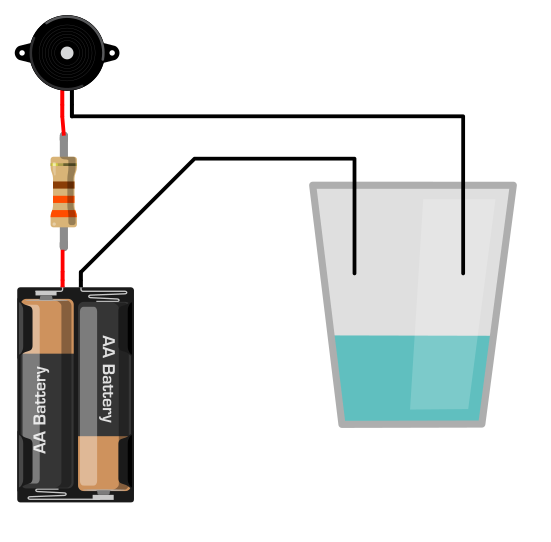Friday Fun - Look No Code!
Recently my uncle has discovered that his vision is deteriorating, and even simple tasks such as making a cup of tea are becoming troublesome.
This reminded me of something that I saw on CBBC Newsround (a news show for children) back in the 80/90s where a device was placed on top of a cup, and it detected when the water reached the device using two probes made of metal. When the water touched the probes it caused the alarm to sound and the user would stop pouring water.
So with that in mind I decided to make my own using only a few electronic components, and most importantly NO CODE
Yup you read that right, this project is purely simple electronics! No coding is required.
For this project you will need
- A battery (9V is ideal, but 2 x AA, 3V can be used)
- Battery box / connector
- 330 Ohm Resistor (ORANGE-ORANGE-BROWN-GOLD) (for 9V only)
- Length of wire, cut in two and the ends stripped.
- Buzzer
- Breadboard
- Glass of water
Building the project.

We start by connecting the red wire, typically the VCC wire to the buzzer.
9V instructions
If you are using a 9V battery then use the resistor in line, so that it connects the red wire to the positive leg of the buzzer.
2 x AA batteries instructions
If you are using 2 x AA batteries, then you can just directly connect the red wire to the positive leg of the buzzer.
The black wire, typically ground (GND) is connected to a length of wire.
Another length of wire connects the negative leg of the buzzer to the glass.
We have created an open circuit, the black wires from GND of our battery need to connect to the negative leg of the buzzer in order to make a sound. So how do we connect them?
The water connects them!

When more water is added to the glass, the two wires are connected, closing the circuit and triggering the buzzer to sound!
Water and electricity! Think of the children!
Typically water and electricity should never be mixed. High voltages and puddles of water are dangerous. When playing with this project you are relatively safe from harm, but do take care and if in doubt ask someone for help.
So what use is this?
This simple project can be made into a product that helps the blind to make tea, run a bath or wash up. It can be made on a bigger scale too! A Raspberry Pi Zero W, with probes connected to the GPIO can be used to detect rising water levels and then send an alert using a service such as Twitter, Pushover or MQTT. Just let your imagination run wild!
Happy Hacking!